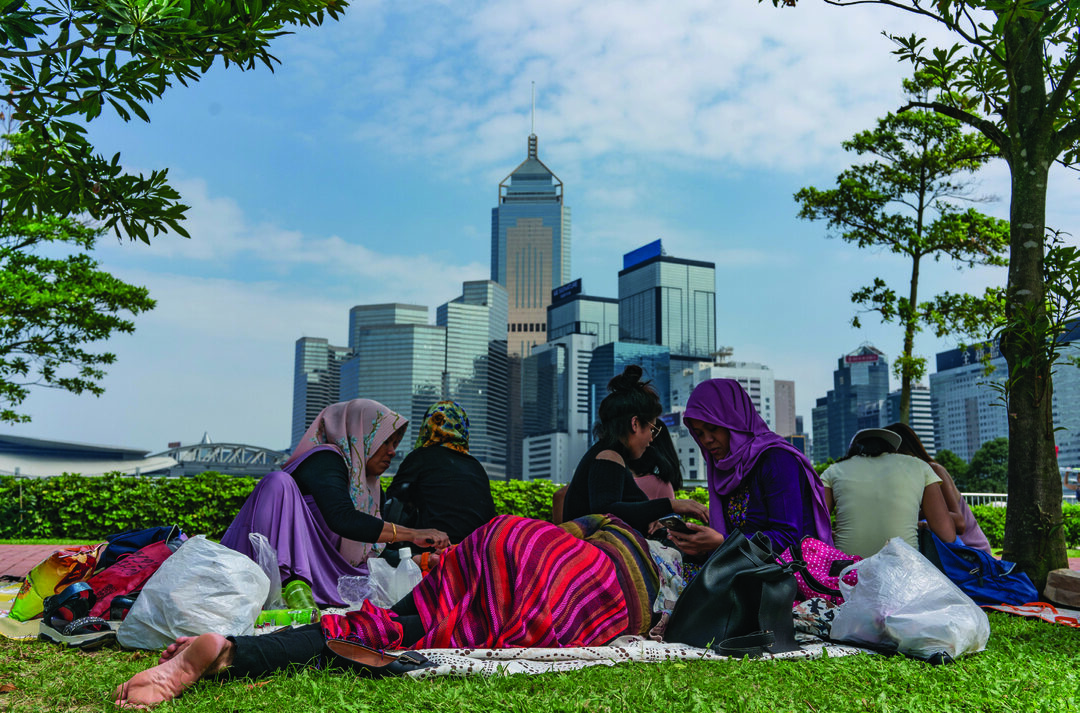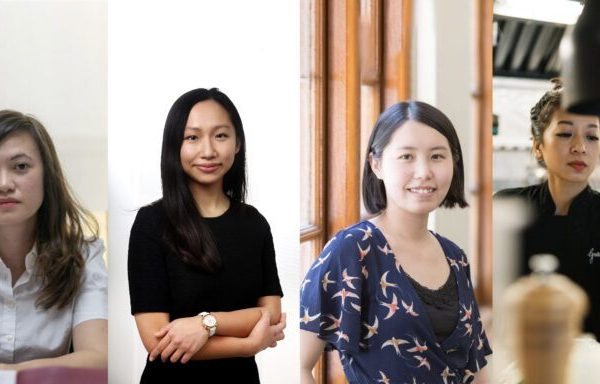The Other 1 Per Cent: Hong Kong rarely approves protection claims to resettle refugees
Navigating Chungking Mansions in Tsim Sha Tsui is an exhilarating experience. A labyrinth of boarding houses and shops, the half-century-old Kowloon landmark is a hub of activity where thousands of individuals from all corners of the world eat, sleep, shop, socialise, and conduct business.
But to a particularly marginalised population in Hong Kong, Chungking Mansions is also a sanctuary. On the 17th floor of one of the building’s many tower blocks, sits the Centre for Refugees – the only drop-in service centre for asylum seekers in the city. Run by Christian Action, a local non-profit that strives to help Hong Kong’s most disadvantaged communities, the centre provides everyday essentials, food, language classes, training programmes, counselling, and several community activities.
A whiteboard lists upcoming activities: football training, art and poetry classes, even a seminar on globalisation by Professor Gordon Mathews of The Chinese University of Hong Kong. These services fill a much-needed gap in a city where legal hurdles often send asylum seekers into a perpetual state of limbo. A lot can, and does, go wrong as asylum seekers wait for their fates to be decided.
“We have over 20 counsellors providing different types of therapies as many clients go through a great deal of trauma. I know one man who just gets worse and worse every week. He feels discriminated against and believes there’s no hope,” says Jeffrey Andrews, a social worker with Christian Action who helps his clients navigate the obstacles. “Imagine an individual who’s been waiting for their case for 10 years. What can they do?”
Years in Limbo
According to estimates by Hong Kong’s Security Bureau, there are currently around 13,100 protection claimants in the city.
These individuals often fit the definition of ‘refugees’ provided by the United Nations as “someone who has been forced to flee his or her country because of persecution, war, or violence.” However, Hong Kong has a different set of terminology. This is because Hong Kong is not a signatory to the UN’s 1951 Refugee Convention. Ratified by 145 states, the international treaty and its subsequent 1967 protocol outline the rights of refugees and legal obligations of host nations.
As Hong Kong also does not offer asylum, legally, NGOs refer to individuals who would be considered asylum seekers and refugees elsewhere in the world as “protection claimants.” Furthermore, according to Hong Kong law, they are “illegal immigrants,” and hence granted none of the rights that legal residents in the city enjoy.
Refugee laws in Hong Kong were first decided by the UK when the territory was still under colonial rule and, later, by China after the 1997 handover of sovereignty. While both China and the UK are signatories, neither country extended the 1951 Refugee Convention to Hong Kong.
Hong Kong does not follow the UN’s convention to accept refugees in the city, but it has been a signatory of the UN Convention Against Torture (UNCAT) since 1992 and, as such, has a non-refoulement policy in place that prevents the return of individuals to a country where they are at risk of torture, or face “cruel, inhuman, or degrading punishment.”
The policy also recognises fear of persecution: In 2013, the city’s courts ruled that, even though Hong Kong is not bound by the 1951 Refugee Convention, the Immigration Department has a duty to independently assess whether a claimant’s fear of persecution is well-founded.
Upon arrival in the city, protection claimants can lodge a non-refoulement claim with the hope that they will be resettled in another country, such as Canada.
If an individual’s case is successful, the government will permit that person to remain until they are able to resettle abroad, which can take years. On the other hand, if a claim is rejected, the authorities will return the person to their country of origin.
Hong Kong does not accept refugees, but it has a non-refoulement policy in place.
Officially introduced in March 2014 following a series of landmark court cases, the current system for assessing non-refoulement claims is known as the Unified Screening Mechanism (USM). It’s designed to be more comprehensive than its predecessor and process all claims under “high standards of fairness.”
Three legal foundations have formed the legal grounds for the USM. The first is torture, as defined under UNCAT. The second is torture or cruel, inhuman, or degrading treatment or punishment, as well as the right to life, as set out in the Hong Kong Bill of Rights, including Article 3. The third is persecution, with reference to Article 33 of the 1951 Refugee Convention, which prohibits states to “expel or return (refouler) in any manner whatsoever to the frontiers of territories where his (or her) life or freedom would be threatened on account of his race, religion, nationality, membership of a particular social group or political opinion.”
Patricia Ho, a Hong Kong-based human rights lawyer, says that most asylum seekers arrive via plane. At Hong Kong International Airport, they can make a statement to the Immigration Department explaining why they need protection and should not be sent back to their country of origin. Immigration officers at the airport then share this information with a non-refoulement assessment team to decide whether the claim can be accepted.
If unsuccessful, the Immigration Department will remove the asylum seeker from the airport, sometimes forcibly, and send the individual back to their country of origin. Ho has also heard of instances where people from high-risk regions, such as Egypt and Yemen, have not been allowed to submit an initial claim and have been immediately deported, which she says “demonstrates a clear picture that the government is going to the extent of using illegal means” to stop people from coming in. According to Ho, there have also been accounts of immigration officers torturing claimants during the removal process. When Ariana reached out for comment, the Immigration Department said it cannot respond to allegations without reference to specific cases.
If the preliminary statement is accepted, claimants will be released and instructed to report to Skyline Tower in Kowloon Bay. Alternatively, if officials believe there’s a risk of abscondment, they may detain the protection claimant at Castle Peak Bay Immigration Centre.
Human rights lawyer Patricia Ho has heard of instances where refugees from high-risk regions are not allowed to submit an initial claim, and have been immediately deported,
At this point in time, the Immigration Department will confiscate the claimant’s passport, which will not be returned throughout their assessment unless specifically requested for administrative reasons, such as opening a bank account. In each case, claimants are given recognisance papers – temporary identification that allows them to stay in the city while they await the government’s decision.
Next, claimants are assigned a lawyer and instructed to file their official non-refoulement claim form within 28 days. Immigration officials then assess the merits of their claim; if the official claim is rejected, individuals can lodge an appeal with the Torture Claims Appeal Board.
Should the claimant fail in their appeal process, they can then lodge a judicial review as a last resort. This legal process examines whether an administrative decision is unfair, unreasonable, unconstitutional, or illegal. If a claimant is successful in a judicial review, the court will not only re-assess the asylum seeker’s case, but also determine whether the Immigration Officer or Department acted correctly when assessing the claim.
According to casework experience of the Justice Centre Hong Kong – a non-profit that focuses on providing legal and psychosocial support for vulnerable migrants as well as research and advocacy work – the processing time for an average claimant who has lodged a case after the implementation of USM is about six to eight months. If their application is denied, it usually takes another six to 12 months for an appeal. Should an asylum seeker lodge a judicial review, it can take another nine months to two years.
The timelines can expand or contract due to several factors. If, for instance, the claimant applies for legal aid or speaks a language for which interpreters are not readily available, it could take much longer. However, it’s still an improvement from Hong Kong’s earlier model.
For cases lodged before 2014, the year that USM was implemented, the process is significantly longer and more complicated – it can take over a decade in some instances, rather than months or years. One Justice Centre client who lodged a claim in 2007 is still undergoing legal proceedings, more than a decade later.
During this period, claimants have few means to track their cases. All they can do is wait to be notified of the result. Even so, they must report to the Immigration Department on a regular basis, though the frequency differs from person to person.
This process also applies to asylum seekers who are smuggled into Hong Kong by human traffickers, as well as those who enter the city on valid visas but who seek non-refoulement to prevent deportation after their prescribed stay runs out. However, in the latter scenario, they can only apply to have claims assessed under the USM if and when they overstay their visa.
Given Hong Kong’s high cost of living, subsidies are insufficient and the government does not allow asylum seekers to work or seek employment.
While claims are being processed, the Hong Kong government provides each asylum seeker with a monthly stipend of HK$1,200 for food in the form of supermarket coupons; HK$1,500 for housing; and a few hundred dollars for transport and utilities – determined by the Social Welfare Department and distributed by the International Social Service.
Given Hong Kong’s high cost of living, these subsidies are insufficient, especially as the government does not allow asylum seekers to work or seek employment. The government has maintained that the relatively nominal support is justified, arguing that it does not want to create “a magnet effect which could have serious implications on the sustainability of our current support systems and on our immigration control.”
“It’s not easy to find a place to rent for HK$1,500 [a month] now in Hong Kong,” Andrews says, adding that the government could examine the current housing market to identify the challenges. “The government can improve on that, seeing the reality of the situation.”
A Knee-jerk System
According to the Immigration Department, 21,553 non-refoulement claims have been determined between 2009 and 2019. Out of those, only 172 (or about 0.80 per cent) have been successful in achieving non-refoulement status and resettled internationally.
Human rights advocates generally agree that Hong Kong needs to step up its efforts. When compared with other developed cities, where asylum seekers are allowed to remain on humanitarian grounds, Hong Kong does not do its part to protect the world’s most vulnerable people.
“Hong Kong is such a rich city,” says Justice Centre Senior Research and Policy Officer Annie Li. “It should share more of the responsibility.”
Patricia Ho notes that the success rate for claims is one of the lowest in the world, a fact, she says, that “speaks for itself.” However, she adds that it could also be a reflection of the large amount of people who genuinely do not fulfil the criteria of non-refoulement claims.
Ho says that Hong Kong’s system has been developed in a “passive” and “knee-jerk” way, with the government only moving to implement new policies after court rulings. She recalls having worked with a client who underwent over 100 interviews before ultimately being successful, because she believes officers were deliberately trying to buy time or find inconsistencies in the case. And, in some instances, Ho says unaccompanied minors underwent extensive questioning, and some were even detained.
Such treatment has not continued unchallenged. For example, the Court of First Instance made a declaration in a 2008 case, FB and Ors v Director of Immigration and Secretary for Security, that officers are “insufficiently trained or instructed in respect of the screening and decision-making process on the claim.” Slowly, with a series of judicial reviews, several instances of unfair procedures have been corrected. For instance, claimants are now entitled to legal representation – a right that was introduced after the 2008 court case.
While the procedure has improved, Ho says, the training of immigration officers falls far short of international standards. “The job continues to be done by people who have only been trained to remove non-Hong Kong residents [such as asylum seekers],” she says, adding that many of the officers are on job rotation schedules and, therefore, may not be specifically qualified for assessment purposes.
“With that type of [rotational] employment process, the reality is that it’s very hard for them to do things in a fair manner.”
Patricia Ho says Hong Kong’s immigration officers are often “only trained to remove non-Hong Kong residents such as asylum seekers.”
Untapped Potential
For the less than one per cent of asylum seekers who see their non-refoulement claim substantiated by the government, the most they can hope is to be resettled in a safe country. They will not be granted the right to remain in Hong Kong.
The government maintains that “the Refugee Convention and its 1967 Protocol have never been applied to Hong Kong and our firm policy of not determining the refugee status or granting asylum to anyone.”
The government argues that this stringent system is in Hong Kong’s best interest, since the city’s prosperity could be too alluring to immigrants. In a response to an appeal from the UN to reconsider its stance on refugee policy in 2018, the government said that it did “not see any change to the circumstances of Hong Kong that justify a departure from our position of not applying the Refugee Convention to Hong Kong.”
Furthermore, the statement argued that Hong Kong’s situation is unique, given its high population density, liberal visa policies, high volumes of visitors, and sophisticated transit system, continuing: “Hong Kong is particularly vulnerable to the ill effects of illegal immigration.”
As a result, asylum seekers must be resettled in another country, and it might be years before there is such an opportunity due to the speed at which that country issues travel documents. Many asylum seekers have been in Hong Kong for over a decade and haven’t seen family members back home since they first arrived.
“We saw that [protection claimants] were getting depressed; they were getting isolated; they were getting lonely,” Andrews says. “I’ve seen clients just going downwards in terms of mental wellbeing.”
Even with a successful claim, asylum seekers’ situation improves very little. Unlike countries that have signed the UN treaty, the government classifies asylum seekers as “illegal immigrants” by default, meaning they cannot be granted official residency in Hong Kong, regardless of the number of years they have lived here. While they can’t obtain residency, successful claimants can apply to the Immigration Department for permission to work.
Christian Action, for example, has successfully helped 30 of its clients secure the right to work. However, these permissions are by no means a guarantee. They must be reassessed every six months, which can cause job insecurity and take an emotional toll on the asylum seeker, as they may face pressure from the employers and delays in salary payment, Andrews says. It also makes it challenging for employers to hire asylum seekers, since businesses must endure the long bureaucratic process of re-filing forms every six months and run the risk of losing their employees.
Hong Kong NGO Christian Action says while it has successfully helped several asylum seekers secure the right to work, these permissions are by no means a guarantee.
Unsurprisingly, successful employment applications are few and far between. However, that’s changing: In 2014, the Immigration Department granted only five applications for the permission work, but the number rose to 55 as of 2019. The department has said in a Freedom of Information request that this permission is granted on a “discretionary and exceptional” basis.
Permission is usually granted after considering the impact on the local employment sector, security concerns, and the personal circumstances of the applicant. Most often, asylum seekers are denied because the department was “unable to give any meaningful consideration in the absence of sufficient relevant supporting information.”
The children of asylum seekers in Hong Kong, of which there are at least 900, face a similar predicament as they grow up. “They grew up in Hong Kong, everything they know is here, they speak Cantonese” says Patricia Ho. Yet they may not have a passport from either their family’s country of origin or from Hong Kong. When they finish secondary education, which is provided free-of-charge by the government, they are unable to work or travel. Ho says that if these children are recognised as residents and were able to seek employment, pay taxes, and contribute to wider Hong Kong society, then they would be a source of “clear untapped potential.”
Annie Li says it’s a missed opportunity, since asylum seekers would fill a need for workers in industries with labour shortages. In addition, the right to work would enable asylum seekers to cover their own expenses, thus alleviating the financial burden faced by taxpayers and empowering individuals to contribute to the community.
The government argues that allowing asylum seekers to work would attract an influx of asylum seekers to the region, hence opening “a floodgate for the admission of foreign workers.” However, Li says the government has never released any numbers to support this claim.
Ultimately, advocates say that the uncertain legal status asylum seekers face in Hong Kong is in urgent need of reform. “It’s the most demoralising thing for someone to wait 10 years for their case to be accepted,” Ho laments, “only to find out that the situation is exactly the same as it was before and that they can’t move on with their lives.”




